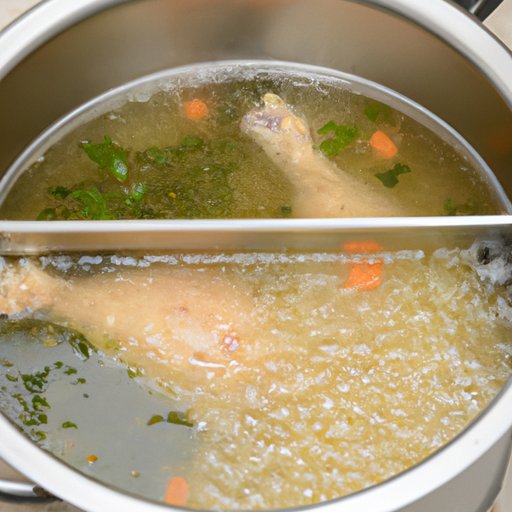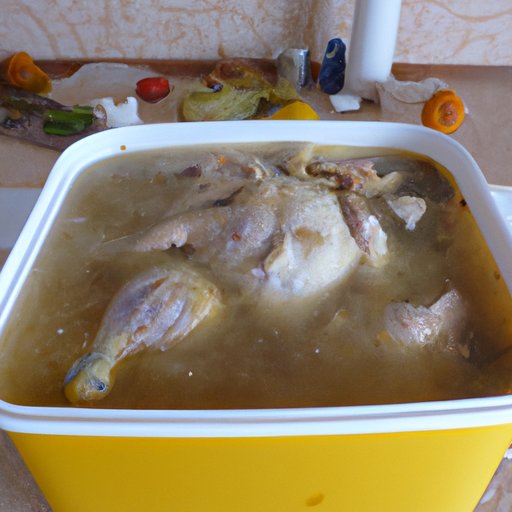Introduction: What is Chicken Broth and Why Is It Important?
Chicken broth is a flavorful liquid made by simmering chicken bones, vegetables, herbs, and spices in water. It’s a popular ingredient in many recipes, including soups, sauces, gravies, and stews. Chicken broth is also a nutritious source of vitamins and minerals, such as calcium, magnesium, phosphorus, potassium, and zinc.
However, when stored or cooked improperly, chicken broth can become unsafe to consume. This is why it’s important to understand the proper techniques for preparing and cooling chicken broth, so that you can enjoy its delicious flavor and nutritional benefits without putting your health at risk.

Preparing and Cooling Chicken Broth Safely
Before you start cooking chicken broth, it’s important to understand the potential health risks associated with leaving it out too long. If chicken broth is left out at room temperature for more than two hours, bacteria can begin to grow, which can lead to food poisoning.
Benefits of Quickly Cooling Chicken Broth
The best way to avoid this is to quickly cool the broth after it has been cooked. Cooling chicken broth quickly helps to limit the growth of bacteria, as well as preserve its flavor and nutrients. In addition, cooling chicken broth quickly helps to reduce the chances of spoilage and food waste.
Best Practices for Storing Chicken Broth After Cooking
Once the chicken broth has cooled, it should be stored in an airtight container in the refrigerator. Refrigerated chicken broth can keep for up to four days. For longer storage, freeze the broth in an airtight container or freezer bag. Frozen chicken broth can keep for up to three months.
How to Quickly Cool Chicken Broth to Prevent Bacterial Growth
Cooling chicken broth quickly is essential for preventing the growth of harmful bacteria. Here are some tips for keeping chicken broth at the right temperature:
- Transfer the broth to shallow containers. This will help it cool faster.
- Place the containers in an ice bath. This will speed up the cooling process.
- Stir the broth occasionally. This will help to evenly distribute the heat.
- Check the temperature periodically. The broth should be cooled to 40°F (4°C) within two hours.
Different Techniques for Quickly Cooling Chicken Broth
In addition to the above tips, there are several other techniques you can use to quickly cool chicken broth. These include:
- Portioning the broth into smaller containers. This will help it cool faster.
- Placing the containers in the freezer. This will reduce the temperature of the broth quickly.
- Adding cold water or ice cubes to the broth. This will help to lower the temperature.
What Happens if You Leave Chicken Broth Out Too Long?
If chicken broth is left out at room temperature for more than two hours, bacteria can begin to grow. This can lead to food poisoning, which can cause symptoms such as nausea, vomiting, diarrhea, and abdominal pain. In severe cases, food poisoning can even lead to death.
Potential Health Risks from Leaving Chicken Broth Out Too Long
It’s important to remember that food poisoning caused by bacteria in chicken broth can be very serious. Symptoms can range from mild to severe, and can last anywhere from a few hours to several days. In extreme cases, food poisoning can even lead to hospitalization or death.
How Long Can You Leave Chicken Broth Out Before it Spoils?
To avoid the potential health risks of leaving chicken broth out too long, it’s important to cool it quickly after cooking. Chicken broth should be cooled to 40°F (4°C) within two hours. If it’s left out at room temperature for longer than two hours, it should be discarded.

Conclusion: Summary of the Health Risks of Leaving Chicken Broth Out Too Long
Chicken broth is a flavorful and nutritious ingredient that can be used in a variety of recipes. However, it’s important to understand the potential health risks associated with leaving it out too long. Bacteria can begin to grow in chicken broth if it’s left out at room temperature for more than two hours, which can lead to food poisoning and other serious health issues.
The best way to avoid these risks is to quickly cool the broth after it has been cooked. Transfer the broth to shallow containers and place them in an ice bath. Stir the broth occasionally and check the temperature periodically. The broth should be cooled to 40°F (4°C) within two hours. For longer storage, refrigerate or freeze the broth in an airtight container.
By following the above tips, you can safely prepare and store chicken broth, so that you can enjoy its delicious flavor and nutritional benefits without putting your health at risk.
(Note: Is this article not meeting your expectations? Do you have knowledge or insights to share? Unlock new opportunities and expand your reach by joining our authors team. Click Registration to join us and share your expertise with our readers.)
